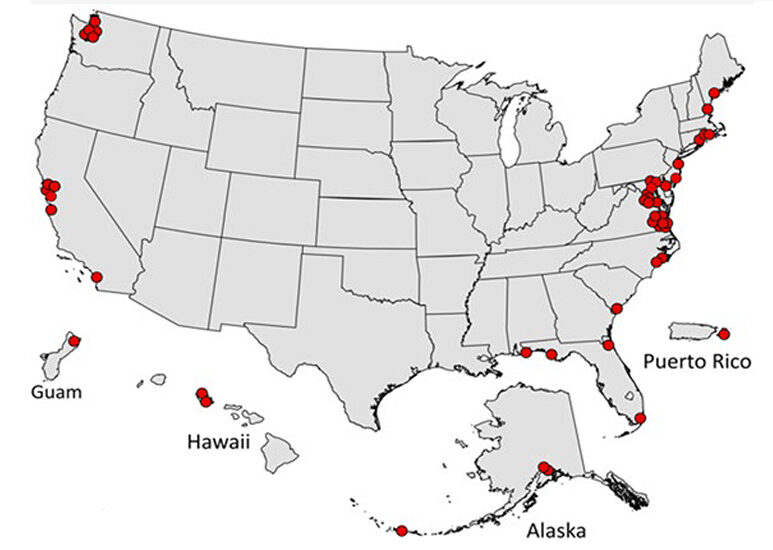
One-third of Federal Superfund Sites Are at Risk as Sea Level Rise Quickens

Nearly one-third of 157 federal facilities designated as Superfund sites on the U.S. Environmental Protection Agency’s National Priorities List may be at risk from sea level rise or increased storm surges, according to a new report by the agency’s Inspector General.
Many of those sites—all military facilities—are near population centers and important ecological areas. About three million people live within one mile of a federal Superfund site, and about 13 million are within three miles, said the report.
Superfund sites can be either federal facility sites, which are owned or operated by the federal government, or private facility sites. EPA oversees cleanup of federal facility sites.
The National Oceanic and Atmospheric Administration categorizes sea-level rise as a global concern, with the pace accelerating—from 0.06 inches per year for most of the last century to 0.14 inches from 2006 through 2015, the report stated. Sea levels along the contiguous U.S. will rise 10 to 12 inches by 2050, increasing floods and storm surges, it added..
Critical Impairment
Cleanup remedies that have already been implemented at federal facilities are susceptible to such extreme weather events, which could also “critically impair” ongoing cleanup efforts, the Inspector General said.
“If cleanup remedies fail or are otherwise impaired, that may result in the spread of contaminants and increase the risk of human and environmental exposure of these contaminants,” the report said. This could affect the health, jobs and environment of millions of U.S. citizens and waste the federal dollars already expended to implement the remedies, it added.
Research from First Street, a nonprofit climate risk data firm, shows that 2,702 sites are classified as Superfund or hazardous waste sites, Jeremy Porter, head of climate implications research, told ENR in an email. Of those, 207, about 7.7%, show moderate or higher flood risk, he said Porter, cautioning that his data do not separate Superfund sites from larger hazardous waste site groupings.
The Inspector General report mapped site locations using data from NOAA and National Weather Service modeling, identifying 49 of the 157 federal facility sites that are at risk. The report highlights three regions—Chesapeake Bay, Puget Sound and San Francisco Bay—each of which have multiple federal facility sites, and combined account for 26 of the 49 federal facility Superfund sites.
The report offered no recommendations but said it is up to EPA managers to make any final decisions on how to move forward. EPA did not provide a formal response to a draft of the report but staff did provide technical comments incorporated into it.
An Inspector General office spokesperson told ENR in an email that EPA beecause this report contains no recommendations, “the agency is not required to respond to it, and we have not received a response.”
EPA Proposed Funding
The report comes amid calls by the Trump administration to slash jobs and reduce EPA’s budget next year to $4.2 billion, less than half of its current $9.1 billion. The move would include cuts to the agency’s Superfund program. In addition to annual appropriations funding, however, EPA is expected to receive about $1.6 billion in Superfund tax receipts in fiscal 2026 that is not reflected in the budget total, the administration said in the proposal. The additional revenue will support continued Superfund cleanup and enforcement, it said.
“EPA is fully transitioning the Superfund Remedial Program to Superfund taxes to conduct critical pre-construction projects, continue ongoing construction projects and initiate new remedial work at National Priority List sites to address contaminants including lead and per- and polyfluoroalkyl substances (PFAS),” the agency said, adding that Superfund tax receipts will support the Superfund Federal Facilities Program and Emergency Response and Removal Program.
Post a Comment
You must be logged in to post a comment.





